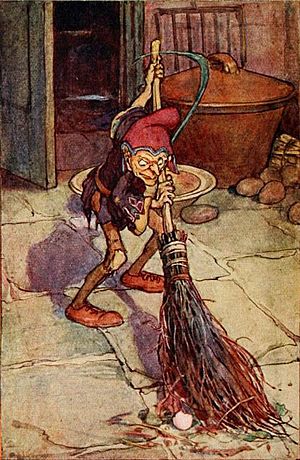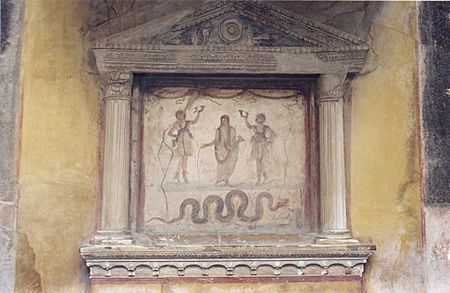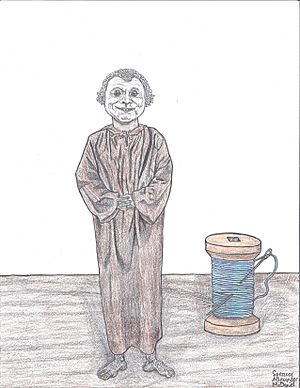Brownie (folklore) facts for kids
|
Illustration of a brownie sweeping with a handmade broom by Arthur Rackham
|
|
| Grouping | Legendary creature |
|---|---|
| Sub grouping | Fairy Goblin Household spirit |
| Other name(s) | Brounie Urisk Brùnaidh Ùruisg Gruagach |
| Country | Scotland and Ireland |
| Habitat | Within the home |
A brownie or broonie is a special spirit from Scottish folklore. These spirits are said to live in homes and come out at night while everyone is asleep. They help with chores and farm tasks. To keep a brownie happy, house owners usually leave a bowl of milk, cream, or other food near the fireplace. Brownies can get offended easily. If they feel insulted or used, they will leave the house forever. Brownies are often playful and might even play tricks on lazy servants. If they get very angry, they can sometimes turn into mean spirits called boggarts.
Brownies started as spirits that protected homes, much like the Lares in ancient Roman stories. Brownies are described differently in various places. But they are often seen as ugly, with brown skin and covered in hair. In older stories, they were human-sized or even bigger. More recently, they are often shown as small and wrinkled. They can usually turn invisible and sometimes even look like animals. They often wear old rags. If someone tries to give a brownie new clothes or tries to baptize one, the brownie will leave forever.
The name brownie first came from a local word used only in the UK. But now, it is the common name for all such creatures across the UK and Ireland. In England and Scotland, they are also called hobs, silkies, and ùruisgs. In Wales, they are known as Bwbach, and on the Isle of Man, they are called Fenodyree. Brownies also appear in books, like John Milton's poem L'Allegro. They became popular in children's literature in the late 1800s and are still in modern fantasy stories. The Brownies in the Girl Guides are even named after a story by Juliana Horatia Ewing about brownie folklore.
Contents
The History of Brownies
Brownies began as spirits that protected homes. They are very much like the Lares from ancient Roman times. Lares were believed to be the spirits of family ancestors who protected the home. Both brownies and Lares are seen as solitary spirits who work hard for the family. Both are said to be hairy and wear rags. They also both expect offerings of food or milk.
Like Lares, brownies were sometimes linked to the dead. A brownie was sometimes thought to be the ghost of a servant who used to work in the house. For example, the Cauld Lad of Hylton was said to be the ghost of a stable boy. He would clean up messes but also make new ones if things were too tidy! The menehunes from Hawaiian folklore are also compared to brownies. They are a race of small people who work at night.
In ancient times, families honored their ancestors around the fireplace, called the hearth. This is why offerings for brownies are often left there. The main difference between brownies and Lares is that Lares stayed in one house forever. Brownies, however, could move or leave if they were unhappy. One story tells of a brownie who left a house because the owner fired all the servants. The brownie was doing all the work! He only came back when the servants were hired again.
Brownie Traditions and Habits
What Brownies Do
Stories about brownies are quite similar across Great Britain. They are said to live in homes and on farms. They only work at night, doing housework and farm chores while people sleep. Having a brownie around was thought to bring good luck and wealth to the home. People were expected to leave offerings for the brownie. These offerings included a bowl of cream, porridge, or a small cake. They were usually left on the hearth.
Brownies would punish lazy servants by pinching them in their sleep. They might also break things or cause other mischief. Sometimes, they made noise at night or created messes just for fun. In some old stories, brownies even guarded treasure, which was not their usual job.
Brownies are almost always described as working alone. There is rarely more than one brownie in a house. The brownie linked to a house usually lives in a specific nearby place. This could be a cave, stream, rock, or pond. Some brownies even had names. Around 1650, a brownie in Westmorland was called "Tawny Boy." Another from County Durham was known as "Cauld Lad." Brownies are said to help out of "personal friendships." They might even do extra work, like fetching a midwife when a lady of the house was having a baby.
In 1703, John Brand wrote about Shetland:
Not above forty or fifty years ago, every family had a brownie, or evil spirit, so called, which served them, to which they gave a sacrifice for his service; as when they churned their milk, they took a part thereof, and sprinkled every corner of the house with it, for Brownie’s use; likewise, when they brewed, they had a stone which they called "Brownie’s stane", wherein there was a little hole into which they poured some wort for a sacrifice to Brownie. They also had some stacks of corn, which they called Brownie's Stacks, which, though they were not bound with straw ropes, or in any way fenced as other stacks used to be, yet the greatest storm of wind was not able to blow away straw off them.
How Brownies Look
Brownies are almost always male. But sometimes, female brownies like Meg Mullach (or "Hairy Meg") have been described. They are usually seen as ugly, and their look can be scary to people in the house. They got their name because they are often described as having brown skin and being covered in hair. In the oldest stories, brownies are human-sized or bigger. But later, they became "small, wrinkled, and shaggy." They are often short and round. This description might be linked to how the Devil was described in Scotland in the mid-1600s.
In the late 1800s, the Irish storyteller Thomas Keightley said a brownie was "a personage of small stature, wrinkled visage, covered with short curly brown hair, and wearing a brown mantle and hood." Brownies usually wear rags. Brownies from the Scottish Lowlands were said to have no noses, just a single hole in their face. In Aberdeenshire, some brownies were described as having no fingers or toes. Sometimes, brownies are said to look like children wearing white tunics.
Like the Phooka in Irish stories, brownies are sometimes said to change into animals. They can usually turn invisible. But they rarely need to, as they are already very good at sneaking and hiding. A story from Peeblesshire tells of two maids who stole milk and a bannock left for the brownie. They sat to eat, but the brownie sat invisibly between them. Every time they tried to eat or drink, the brownie would steal it. The maids argued, blaming each other. Finally, the brownie laughed and shouted: "Ha, ha, ha! Brownie has't a'!"
Why Brownies Leave
If a brownie feels disrespected or used, it will disappear forever. It will also take the house's good luck with it. Sometimes, a brownie might get very angry and destroy all its work before leaving. In extreme cases, brownies can even turn into mean boggarts if they are angered. A brownie might get upset if a human watches it work, criticizes it, or laughs at it. Brownies especially hate anything they see as disrespect.
The brownie at Cranshaws in Berwickshire mowed and threshed grain for years. Then someone said the grain was poorly done. That night, the brownie carried all the grain two miles away to Raven Crag. He threw it off the cliff, muttering:
It's no' weel mow'd! It's no' weel mow'd!—
Then it's ne'er be mow'd by me again;
I'll scatter it owre the Raven Stane
And they'll hae some wark ere it's mow'd again!
A brownie can also be driven away if someone tries to baptize it. In some stories, even how their cream is given can make them leave. The brownie of Bodsbeck left because the owner called for him after pouring the cream, instead of letting him find it himself.
Sometimes, giving a brownie a name was enough to make it leave. A brownie near Pitlochry in Perthshire was often heard splashing in the water. He would go to a nearby farm every night. If things were messy, he would tidy them. If things were tidy, he would make a mess. People feared him. One night, a man heard him splashing and called him "Puddlefoot." Puddlefoot cried out, "I've gotten a name! 'Tis Puddlefoot they call me!" Then he vanished forever.
Gifts of Clothing
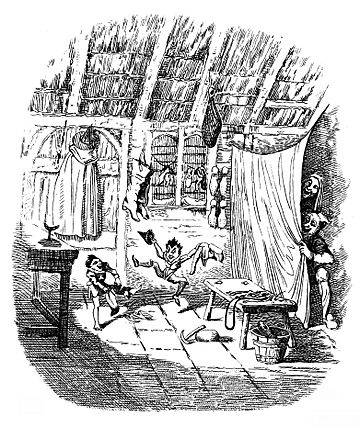
If a family gives a brownie clothes, it will leave forever and stop working for them. The first English story of a brownie disappearing after getting clothes is from 1584. Sometimes, brownies say a short poem before they leave. One Scottish brownie angrily said:
Red breeks and a ruffled sark!
Ye'll no get me to do your wark!
Another from Berwickshire said:
Gie Brownie a coat, gie Brownie a sark,
Ye'se get nae mair o' Brownie's wark.
People have different ideas why brownies leave when given clothes. The most common idea is that the brownie sees the gift as an insult. One story from Lincolnshire (1891) says a brownie used to linen shirts got angry when given a shirt made of rough sackcloth. The brownie sang before disappearing:
Harden, harden, harden hamp,
I will neither grind nor stamp;
Had you given me linen gear,
I have served you many a year.
Thrift may go, bad luck may stay,
I shall travel far away.
The Cauld Lad of Hilton seemed to want clothes and was thankful for them. But he still left after getting them. At night, people heard him working and sadly singing:
Wae's me! Wae's me!
The acorn is not yet
Fallen from the tree,
That's to grow to the wood,
That's to make the cradle,
That's to rock the bairn,
That's to grow a man,
That's to lay to me.
After servants gave him a green cloak and hood, he happily sang before disappearing:
Here's a cloak, and here's a hood!
The Cauld Lad of Hilton will do no more good!It is thought that the Cauld Lad might have felt "too grand for work." Or perhaps the clothes freed him from a curse. A brownie from Jedburgh also wanted clothes. Servants heard him say, "Wae's me for a green sark!" The laird (landowner) had a green shirt made for him. It was left out, and the brownie disappeared forever. People thought he went to Fairyland.
Brownie's Seat
In the 1800s, the hook used to hang pots over the fire had a bend in it. In Herefordshire, this bend was called the "brownie's seat" or "brownie's sway." If the hook did not have a bend, people would hang a horseshoe upside-down. This was so the brownie would have a place to sit. The brownie at the Portway Inn in Staunton on Wye often stole the family's keys. To get them back, the family had to sit around the fireplace. They would put a piece of cake on the hob (a flat part of the hearth) as an offering. Then they would sit with their eyes closed, completely silent. The missing keys would then be thrown at them from behind.
Different Kinds of Brownies
The name brownie became common in the early 1500s in Scotland and along the English border. Now, it is the standard name for many similar creatures in British folklore. Stories about brownies are more common in England and the Lowlands of Scotland than in Celtic areas. Still, there are stories of Celtic brownies.
Bwbach
The Welsh name for a brownie is Bwbach. Like brownies, Bwbachod can get very angry if upset. A Welsh historian from the 1100s, Gerald of Wales, wrote about a Bwbach that caused trouble for a family it was angry with. In the 1800s, folklorist Wirt Sikes described the Bwbach as a "good-natured goblin" who did chores for Welsh maids. He said that before bed, a maid should sweep the kitchen, make a fire, and put a churn of cream by the fire with a fresh bowl of cream. The next morning, "if she is in luck," the bowl of cream would be empty, and the cream in the churn would be churned. Sikes also said the Bwbach could be a scary ghost that sweeps people away on gusts of air. This happens for restless spirits who cannot sleep because of hidden treasure. If people do not move the treasure, the Bwbach takes them away. This other side of the Bwbach makes it more like the Irish Phooka.
John Rhys, a Welsh scholar, wrote a story from Monmouthshire in his 1901 book Celtic Folklore. It was about a young maid who left a bowl of cream for a Bwbach every night. One night, the Bwbach attacked her, but she screamed. The Bwbach fled to a nearby farm. A girl there fed him well, and he did her spinning. But she wanted to know his name, which he refused to tell. One day, when she pretended to be out, she heard him singing his name, Gwarwyn-a-throt. So he left and went to another farm. There, he became good friends with a manservant named Moses. After Moses died in the Battle of Bosworth Field, Gwarwyn-a-throt started acting like a boggart, causing trouble everywhere. A wise old man managed to call him and send him away to the Red Sea. Parts of this story are found in other brownie tales.
Fenodyree
The Manx name for a brownie is Fenodyree. The Fenodyree is seen as a "hairy spirit of great strength." He can thresh a whole barn of corn in one night. The Fenodyree is thought to be not very smart. One Manx folktale says the Fenodyree tried to gather sheep. He had the most trouble with a small, grey one without horns. This "sheep" turned out to be a hare! The same mistake is also told about a brownie from Lancashire. Like other brownies, the Fenodyree is believed to leave forever if given clothes. In one story, a farmer gave the Fenodyree clothes to thank him. The Fenodyree was offended. He picked up each clothing item, saying what illness it would bring him. Then the Fenodyree left to hide alone in Glen Rushen.
Hobs and Hearth Spirits
Especially in Yorkshire and Lancashire, brownies are called "Hobs." This is because they are linked to the fireplace, or hearth. Like brownies, Hobs would leave forever if given clothes. A Hob in Runswick Bay in North Yorkshire was said to live in a cave called the "Hob-Hole." Parents would bring their children there for the Hob to cure them of whooping cough. The Holman Clavel Inn in Somerset is also said to have a playful Hob named Charlie. Charlie was believed to sit on a holly wood beam above the fire. This beam was called the "clavvy" or "clavey." Once, when a woman was having dinner, servants set the table with "silver and linen." But as soon as they left and came back, Charlie had put everything away. He did not like the farmer she was meeting!
Hobs are sometimes also known as "Lobs." Lob-Lie-by-the-Fire is a large brownie who was said to do farm work. In Scotland, a similar hearth spirit was called the Wag-at-the-Wa. The Wag-at-the-Wa was believed to sit on the pothook. Swinging the pothook was thought to invite him to visit. He was said to bother lazy servants but enjoyed children's company. He is described as a scary, short-legged old man with a long tail. He always wore a red coat and blue pants with an old nightcap. He had a bandage around his face because he always had a toothache. He also sometimes wore a grey cloak. He often laughed with the family if they were laughing. He was said to run away from the sign of the cross.
Silkie
A female spirit called the Silkie appears in English and Scottish folklore. She got her name because she always wore grey silk. Like a ghost, the Silkie is linked to the house, not the family. But like a brownie, she does chores for the family. A famous Silkie was said to haunt Denton Hall in Northumberland. A woman named Marjory Sowerby spoke with the last Hoyles of Denten Hall, two old ladies, about the Silkie. They told her the Silkie would clean the hearth and start fires for them. They also mentioned "something about bunches of flowers left on the staircase." Sowerby left the area around 1902. When she returned after World War II, the Hoyles were gone. The house was owned by a man who did not believe in fairies. The Silkie stories were no longer told. Instead, the house was said to be haunted by a mean poltergeist. It made banging noises and played tricks on the man. He eventually moved out. This is seen as an example of a brownie turning into a boggart.
Silkies were also sometimes believed to appear suddenly on roads at night to lonely travelers and scare them. Another Silkie is said to haunt the grounds of Fardel Hall in Devon. This one looks like a "beautiful young woman with long, golden hair, wearing a long silken gown." She supposedly guards hidden treasure on the grounds. Few people have seen her, but many claim to have heard the rustling of her silk dress. She is believed to kill anyone who gets close to finding the treasure.
Ùruisg
The folklorist John Gregorson Campbell said there was a difference between the English brownie, which lived in houses, and the Scottish ùruisg (also urisk). The ùruisg lived outside in streams and waterfalls and was less likely to help with housework. Even though brownies and ùruisgs are very similar, they have different origins. Ùruisgs are sometimes described as half-man and half-goat. They are said to have "long hair, long teeth, and long claws." They might be old Celtic nature spirits, like the Roman fauns and Greek satyrs. People often saw an ùruisg sitting on a rock at dusk, watching them pass by. In summer, the ùruisg stayed in the wild. But in winter, he would visit local farms at night or live in a local mill.
Wild ùruisgs were troublemakers. But once they were tamed, they were very loyal. Rich families were said to have ùruisgs as household servants. One leader of the Clan MacFarlane was said to have been raised by an ùruisg's wife. The Clan Graham of Angus told stories of an ùruisg that worked for one of their ancestors. The Clan Maclachlan in Strathlachlan had an ùruisg servant named "Harry." The Clan MacNeil of Taynish and the Frazers of Abertarff also claimed to have ùruisg servants. Ùruisgs were also known as ciuthachs or kewachs. A story on the island of Eigg told of a ciuthach that lived in a cave. In some parts of Scotland, similar spirits were called Shellycoats.
Other Types of Spirits
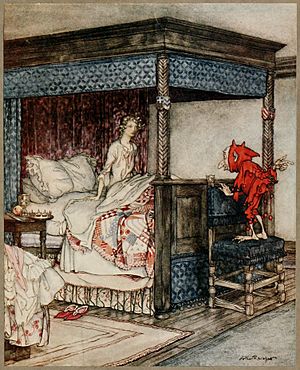 "O Waken, Waken, Burd Isbel", illustration by Arthur Rackham to Young Bekie, showing Billy Blind waking Burd Isobel
"O Waken, Waken, Burd Isbel", illustration by Arthur Rackham to Young Bekie, showing Billy Blind waking Burd IsobelA figure called "Billy Blind" or "Billy Blin" is similar to both the brownie and the Irish banshee. He appears in old songs from the Anglo-Scottish border. Unlike brownies, who usually help with chores, Billy Blind usually only gives advice. He appears in the song "Young Bekie." In it, he warns Burd Isbel, the woman Bekie is supposed to marry, that Bekie is about to marry someone else. He also appears in the song "Willie's Lady" where he gives advice but no practical help.
There are other household spirits in British folklore that haunt specific places. The "cellar ghost" guards wine from thieves. Lazy Lawrence protects orchards. Awd Goggie scares children away from eating unripe gooseberries. And Melsh Dick guards nut bushes. The Kilmoulis is a brownie-like creature from the Scottish Lowlands. It often lives in mills. He is said to have no mouth, but a huge nose that covers most of his face. He loves pranks, and only the miller can control him.
In Texas in 1895, brownies told Arthur Stillwell to build a railroad terminal and the town of Port Arthur. Stillwell said he spoke to brownies since he was four years old. He always took their advice on everything, from where to build to who he would marry. The brownies had warned him not to build his terminal in Galveston because it would be destroyed by a tidal wave.
Brownies in Books and Movies
Early Stories
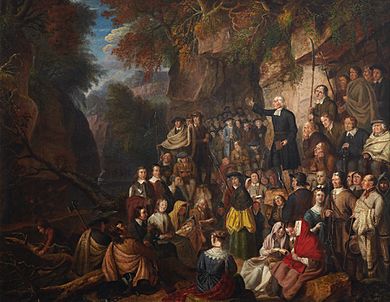 In James Hogg's 1818 novel The Brownie of Bodsbeck, the "brownie" is actually John Brown, a leader of the Covenanters. This painting shows a meeting of Covenanters.
In James Hogg's 1818 novel The Brownie of Bodsbeck, the "brownie" is actually John Brown, a leader of the Covenanters. This painting shows a meeting of Covenanters.A "drudging goblin" or "Lubbar Fend" is described in John Milton's 1645 poem L'Allegro. This "goblin" churns butter, brews drinks, makes dough rise, sweeps floors, washes dishes, and rests by the fire. Like most early brownies, Milton's Lubbar Fend was probably human-sized or larger. In many early stories, the "brownie" turns out to be a normal person. The Scottish writer James Hogg used brownie folklore in his novel The Brownie of Bodsbeck (1818). The story is set in 1685, when a Scottish religious group called the Covenanters was being treated badly. Food goes missing from a farm, and villagers think it is the "brownie of Bodsbeck." In the end, the "brownie" is actually John Brown, the Covenanter leader.
Hogg later wrote about brownies in his short story "The Brownie of Black Haggs" (1828). In this story, the mean Lady Wheelhope orders that any male servants who openly practice religion be shot. Female servants who practice religion are secretly poisoned. A mysterious servant named Merodach stands up to her. Merodach is described as looking like a boy but with features of someone a hundred years old. His eyes are like a monkey's. Characters think Merodach is a brownie. Others say he is a mix of a Jew and an ape, a wizard, a kelpie, or a fairy. Like folklore brownies, Merodach's religion is pagan, and he hates the Bible. He also refuses payment. Lady Wheelhope tries to kill him, but her plans always backfire, leading to the deaths of those she loves. The story never says if Merodach is truly supernatural or just a strange-looking servant. Charlotte Brontë and Emily Brontë knew Hogg's stories. Merodach might have influenced Emily's character Heathcliff in Wuthering Heights (1847). Brownies are also mentioned in Charlotte's novel Villette (1853).
In the late 1800s, children's literature grew very popular and often included fantasy. Brownies were seen as especially appealing to children. Juliana Horatia Ewing used brownie folklore from her childhood in her short story "The Brownies," first published in 1865. In the story, a selfish boy wants a brownie to do his chores because he is too lazy. A wise old owl tells him that real brownies do not exist. The only real brownies are good children who do chores without being asked. The boy goes home and convinces his younger brother to become the new household "brownies." Ewing's story inspired the idea of calling helpful children "brownies."
Brownies in Modern Fantasy
The Fablehaven book series by Brandon Mull features brownies living near the Fablehaven Sanctuary. These brownies look human but are tiny and have leafy ears. They love making desserts. They will fix and improve anything broken in the house overnight if given ingredients. They use these ingredients to make a dessert of their choice. It is said that chocolate brownies were named after them because fairy brownies invented them.
George MacDonald included Scottish brownie features in his 1800s books The Princess and the Goblin and Sir Gibbie. His brownies have no fingers. Warrior brownies appear in the 1988 fantasy film Willow, directed by Ron Howard. These brownies are only a few inches tall and use bows and arrows. They are first shown kidnapping a human baby, but they turn out to be good. Creatures called "house elves" appear in the Harry Potter series by J. K. Rowling. Like traditional brownies, house elves are loyal to their masters and can be freed by a gift of clothing. House elves also look like brownies, being small, but they have larger heads and big, bat-like ears. Rowling's books also include boggarts, which are sometimes traditionally described as brownies who turned mean.
A brownie named Thimbletack is important in The Spiderwick Chronicles book series by Holly Black and Tony DiTerlizzi. He lives inside the walls of the Spiderwick estate and is only visible when he wants to be seen. He is described as "a little man about the size of a pencil" with "black and beetles" eyes and a "large and red" nose. When angry, Thimbletack turns into a mean boggart. The series became a worldwide bestseller. A film based on the books was released in 2008.
Images for kids
Illustration of a brownie by Palmer Cox from his Brownies Around the World (1894). His stories made brownies popular in North American children's books.
A brownie was the mascot for the football team Cleveland Browns and for the baseball team St. Louis Browns in their early years.
See also
In Spanish: Brownie (mitología) para niños


